South Asia faces threat from Islamic State
The Sri Lanka attacks draw attention to the risk posed by militants apparently aligned with the Salafi-jihadist group
Source: South Asia Terrorism Portal (data until April 29, 2019 and excluding Afghanistan) and International Centre for the Study of Radicalisation
Outlook
The April 21 terrorist attacks on hotels and churches in Sri Lanka were the worst in South Asia (excluding Afghanistan) recorded to date in terms of single-day fatalities.
In the wider region, other areas in the last year have been prone to attacks by different types of militancy: broadly left-wing extremism, separatism and Islamism. Kashmir and Pakistan’s Balochistan and Khyber Pakhtunkhwa provinces are highest-risk, with Islamist groups especially active in these restive areas.
A growing Islamist threat across South Asia could arise from groups who are inspired by IS and may have fought for it in the Middle East.
Impacts
- Indian intelligence agencies will explore any links between the perpetrators of the Sri Lanka attacks and IS sympathisers in India.
- Bangladeshi organisations linked to IS may try to recruit from Rohingya refugee camps.
- The Maldives, possibly having the most IS affiliates of any South Asian country, will urgently trace any returnees from the Middle East.
- Churches could be an increasingly attractive target for IS-aligned militants across the region.
See also
- Maldives will manage militancy and virus risks - Jun 16, 2021
- Taliban help suffocate Islamic State's Afghan presence - Apr 17, 2020
- COVID-19 will severely damage Maldives tourism sector - Apr 3, 2020
- Maldives will respond to uptick in terrorism risk - Feb 7, 2020
- Prospects for Pakistan to end-2019 - Jun 24, 2019
- India’s south will be on high alert for terrorism - Jun 13, 2019
- Sri Lanka attacks put the country's Muslims at risk - Apr 23, 2019
- More graphic analysis
